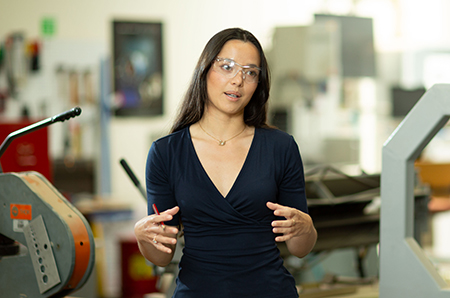Five years ago, Melvin Aguirre was at a crossroads.
Material Transformation
Northrop Grumman Pathways Engineer Ethan Hoben describes himself as a habitual project collector.

by Sheila Gideon
Northrop Grumman Pathways Engineer Ethan Hoben describes himself as a habitual project collector.
Outside of work, he launches rockets, aiming to reach 100 kilometers into the atmosphere. He has three 3D printers which he’s used to build, among other things, a robot that moves by detecting light signals. He’s experimented with a six-bit memory cell — an electronic circuit that stores a small amount of digital data — sparking his interest in semiconductors and advanced manufacturing.
“Cycling through different skills and experiments allows me to keep learning and thinking broadly,” Ethan said. “I have always been interested in a great variety of disciplines, as a broad knowledge often enables more innovative and creative problem solving.”
His curiosity and penchant for big projects ultimately led Ethan to the most ambitious experiment of his early career: a new way to build more efficient, cost-effective antennas.
Finding the Signal
As an undergraduate student at the University of Alabama in Huntsville (UAH), Ethan learned about the complicated, delicate process of fabricating microstrip antennas. These are flat, internal antennas used in satellite communications, cell phones, GPS and more. His passion for antennas — fueled by various projects involving wireless communications — led to a breakthrough during a class project.
“I realized I could 3D print and electroplate antennas, making them safer and more versatile than traditional methods,” said Ethan, who interned at Northrop Grumman during his time at UAH.
In 2023, Ethan joined Northrop Grumman full time through the Pathways program, a three-year rotational program for early-career employees. At home, he continued tinkering with 3D-printing materials, applying various coatings, and then electroplating — coating metals with other metals — the 3D-printed structure to make it behave as an antenna.
“I knew it wouldn’t be perfect, but the math made sense, so I kept experimenting with different shapes and coatings to see what would happen,” Ethan said.
An Inquisitive Culture
While discussing his passion project at work, Ethan learned about the company’s SPARK program through a colleague. This Northrop Grumman initiative supports relevant early research and development (R&D) efforts, evaluating proposals based on their feasibility within a $15,000 budget and three-month timeframe. Ethan submitted a proposal and, six weeks later, received funding for the project, which he is now executing alongside his normal work duties.
Aiming to develop a lightweight antenna that could be virtually any shape and would not require custom machined parts — which can be expensive and slow to fabricate — Ethan began his research using facilities at both Northrop Grumman and UAH, where he is a part-time graduate student. The project, which also serves as the basis of his master’s thesis, is still in-progress but, once proven and adopted, would pioneer a simpler, more cost-effective way to produce microstrip antennas and more.
“The freedom of 3D printing means I can create any antenna for just a few dollars’ worth of material, converting its surface to a metal that transforms it into an antenna,” he said. “The impact would enable Northrop Grumman to rapidly, inexpensively prototype custom antennas while reducing lead times and cost of similarly working antennas.”
Ethan plans to propose more projects in the future. He said that the challenge for him — a self-described tinkerer and fervent learner — isn’t generating the ideas; it’s engaging others to help bring them to life, especially as someone early in his career.
“Without Northrop Grumman’s support for this and other early R&D projects, many excellent ideas would have been lost on napkins, notebooks or as a passing thought,” he said. “Our company culture treasures and respects such ideas and gives them a chance to become something greater.”
Life at Northrop Grumman
Your work at Northrop Grumman makes a difference. Whether you want to design next-generation aircraft, harness digital technologies or build spacecraft that will return humanity to the moon, you’ll contribute to technology that’s transforming the world. Check out our career opportunities to see how you can help define possible.


